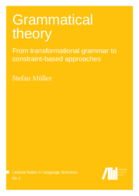Grammatical theory: From transformational grammar to constraint-based approaches
 Author: Stefan Müller
Author: Stefan Müller
Key Words: PSG, GB, GPSG, LFG, CG, HPSG, CxG, TAG, syntax, semantics, German
This book appeared in 2016 in Textbooks in Language Scineces, No 1, Berlin: Language Science Press. The book is a translation and extension of the second edition of my grammar theory book that appeared 2010 in the Stauffenburg Verlag.
This book introduces formal grammar theories that play a role in current linguistics or contributed tools that are relevant for current linguistic theorizing (Phrase Structure Grammar, Transformational Grammar/Government & Binding, Mimimalism, Generalized Phrase Structure Grammar, Lexical Functional Grammar, Categorial Grammar, Head-Driven Phrase Structure Grammar, Construction Grammar, Tree Adjoining Grammar, Dependency Grammar). The key assumptions are explained and it is shown how each theory treats arguments and adjuncts, the active/passive alternation, local reorderings, verb placement, and fronting of constituents over long distances. The analyses are explained with German as the object language.
In a final part of the book the approaches are compared with respect to their predictions regarding language acquisition and psycholinguistic plausibility. The nativism hypothesis that claims that humans posses genetically determined innate language-specific knowledge is examined critically and alternative models of language acquisition are discussed. In addition this more general part addresses issues that are discussed controversially in current theory building such as the question whether flat or binary branching structures are more appropriate, the question whether constructions should be treated on the phrasal or the lexical level, and the question whether abstract, non-visible entities should play a role in syntactic analyses. It is shown that the analyses that are suggested in the various frameworks are often translatable into each other. The book closes with a section that shows how properties that are common to all languages or to certain language classes can be captured.
Outline
- Introduction
- Phrase Structure Grammar
- Transformational Grammar – Government & Binding
- Transformational Grammar – Minimalism
- Generalized Phrase Structure Grammar
- Feature Descriptions
- Lexical Functional Grammar
- Categorial Grammar
- Head-Driven Phrase Structure Grammar
- Construction Grammar
- Dependency Grammar
- Tree Adjoining Grammar
- Inateness of linguistic knowledge
- Generative-enumerative vs. model-theoretic approaches
- Competence/performance distinction
- Language acquisition
- Binary branching
- Generative capacity and grammatical formalisms
- Locality
- Recursion
- Empty Elements
- Extraction, scrambling, and passive: one or several descriptive devices?
- Phrasal vs. lexical analyses
- Universal Grammar and doing comparative linguistics without an a priori assumption of a (strong) UG
- Conclusion
Download
The download of this book is free. If you like this, you may support Language Science Press by signing as a supporter, by helping Language Science Press as Community Type Setter/Proof reader/XML/LaTeX Developer, or by donating money.
- Teaching Material (slides, handouts, etc.)
- BibTeX Entry
- List of all publications that I cite in my books in BibTeX Format
Reviews of the German version
- Review by Karen Lehmann in Zeitschrift für Rezensionen zur germanistischen Sprachwissenschaft, 2012
- Review by Wolfgang Sternefeld und Frank Richter in der Zeitschrift für Sprachwissenschaft, 2012
- Review by Werner Abraham in Germanistik, 2012
- Review by Helga Pető-Szoboszlai in Sprachtheorie und germanistische Linguistik, 22.1, 2012, p. 88–92.
- Review/Comment by Martin Neef on lingbuzz, 2013
Reviews of the English version
- Review by Mike T. Putnam in Glossa, 2017
- Review by Frank Van Eynde in Constructions and Frames, 2018
- Review by Liesbeth Augustinus in Constructions and Frames, 2018

